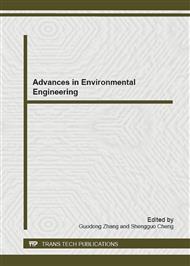[1]
Z.H Yang , J.Huang, G.M Zeng,et al. Optimization of flocculation conditions for kaolin suspension using the composite flocculant of MBFGA1 and PAC by response surface methodology[J], Bioresource Technology,(2009),100:4233–4239.
DOI: 10.1016/j.biortech.2008.12.033
Google Scholar
[2]
H.Salehizadeh, S.A. Shojaosadati, Extracellular biopolymeric flocculants: recent trends and biotechnological importance[J]. Biotechnol. Adv, (2001),19, 371–385.
DOI: 10.1016/s0734-9750(01)00071-4
Google Scholar
[3]
E.Christopher, K.Olga, J.Deborah, et al. Noninvasive therapy to reduce the body burden of aluminium in Alzheimer' disease[J]. J. Alzheimer's Dis. (2006),10, 17–24.
Google Scholar
[4]
C.Rudén, Acrylamide and cancer risk-expert risk assessments and the public debate[J]. Food Chem. Toxicol. (2004),42, 335–349.
DOI: 10.1016/j.fct.2003.10.017
Google Scholar
[5]
J.Huang, Z.H. Yang, G.M. Zeng, et al. Influence of composite flocculant of PAC and MBFGA1 on residual aluminum species distribution[J]. Chemical Engineering Journal. (2012),191:269–277.
DOI: 10.1016/j.cej.2012.03.015
Google Scholar
[6]
P.F. Trond, Aluminum as a risk factor in Alzheimer's disease with emphasis on drinking water[J], Brain Res. Bull. (2001),55 :187–196.
Google Scholar
[7]
J. Labille, F.Thomas, M.Milas, et al. Flocculation of colloidal clay by bacterial polysaccharides: effect of macromolecule charge and structure[J]. Journal of Colloid and Interface Science, (2005),284 (1): 149–156.
DOI: 10.1016/j.jcis.2004.10.001
Google Scholar
[8]
H.Y. Joung, J.K. Sung, H.A.Se, et al. Characterization of a novel bioflocculant, p-KG03, from a marine dinoflagellate, Gyrodinium impudicum KG03[J]. Bioresource Technology. (2007),98 (2): 361–367.
DOI: 10.1016/j.biortech.2005.12.021
Google Scholar
[9]
B.Lian, Y.Chen., J.Zhao, et al. Microbial flocculation by Bacillus mucilaginosus: Applications and mechanisms[J], Bioresource Technology, (2008),99:4825–4831.
DOI: 10.1016/j.biortech.2007.09.045
Google Scholar
[10]
J.Nakamura, S.Miyashiro, Y.Hirose,. Screening: isolation and some properties of microbial cell flocculants. Agricultural and Biological Chemistry.( 1976),40 (2), 377–383.
DOI: 10.1080/00021369.1976.10862059
Google Scholar
[11]
V.Kurenkov,E.Shatokhina,H-G. artan. Sedimentation of Kaolin suspension In the Presence of Praestol Anionie Flocculant and Aluminum Polyoxyehloride And Sulfate Coagulants [J]. Russian Journal of Applied Chemistry,(2005),78(11)1872一1875.
DOI: 10.1007/s11167-005-0625-0
Google Scholar
[12]
Y.Y Hu, B.Y. Gao. Microbial flocculant[M]. Beijing: Chemical Industry Press, (2007): 9−57.
Google Scholar
[13]
B.Lian, Y.Chen, SH. Yuan, et al. Study on the flocculability of silicate bacterial GY03 strain[J], Acta Mineralogical Sinica(in Chinses), (2003),23(5):303-306.
Google Scholar


